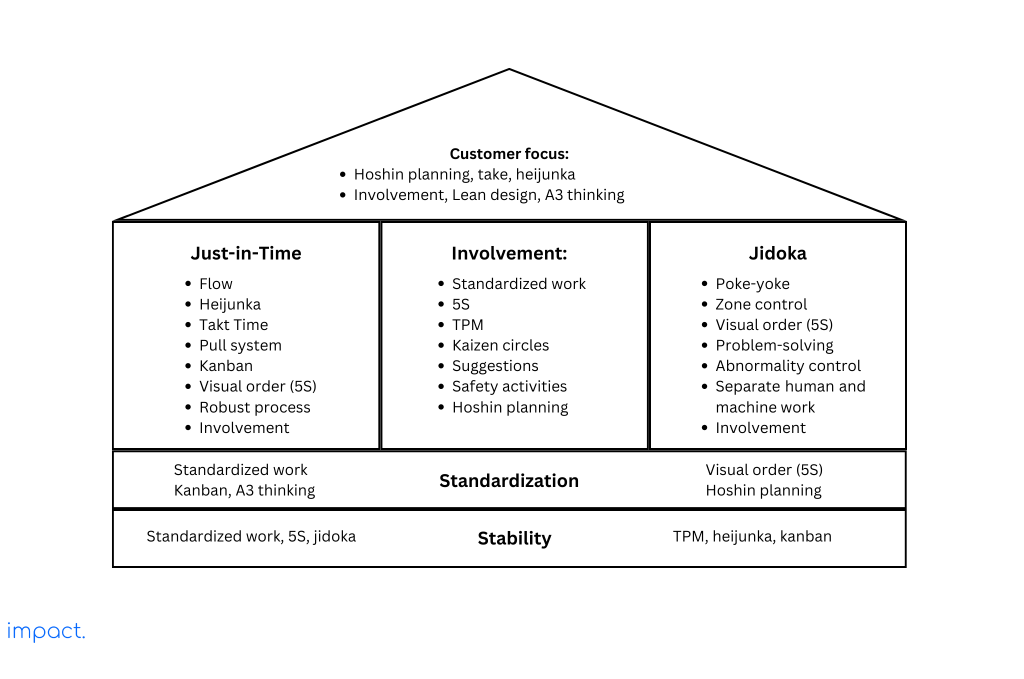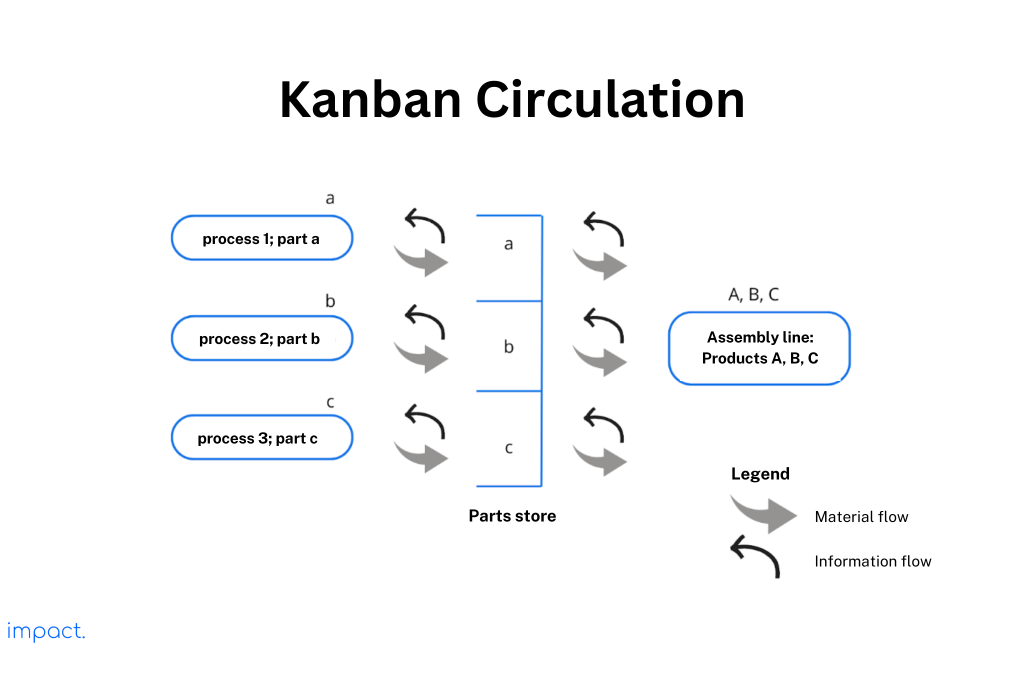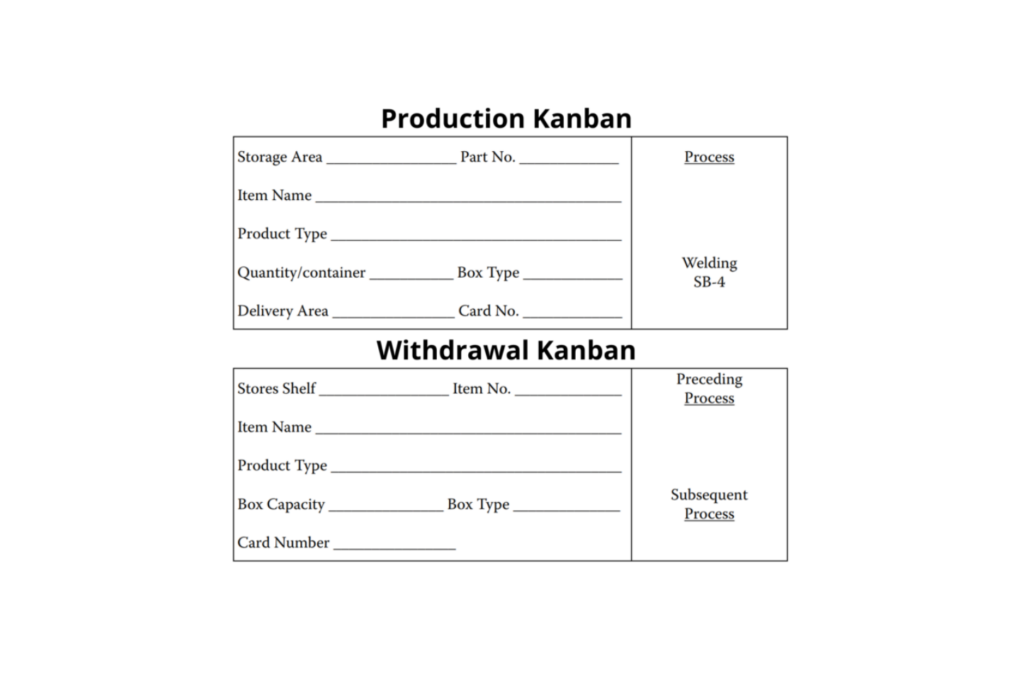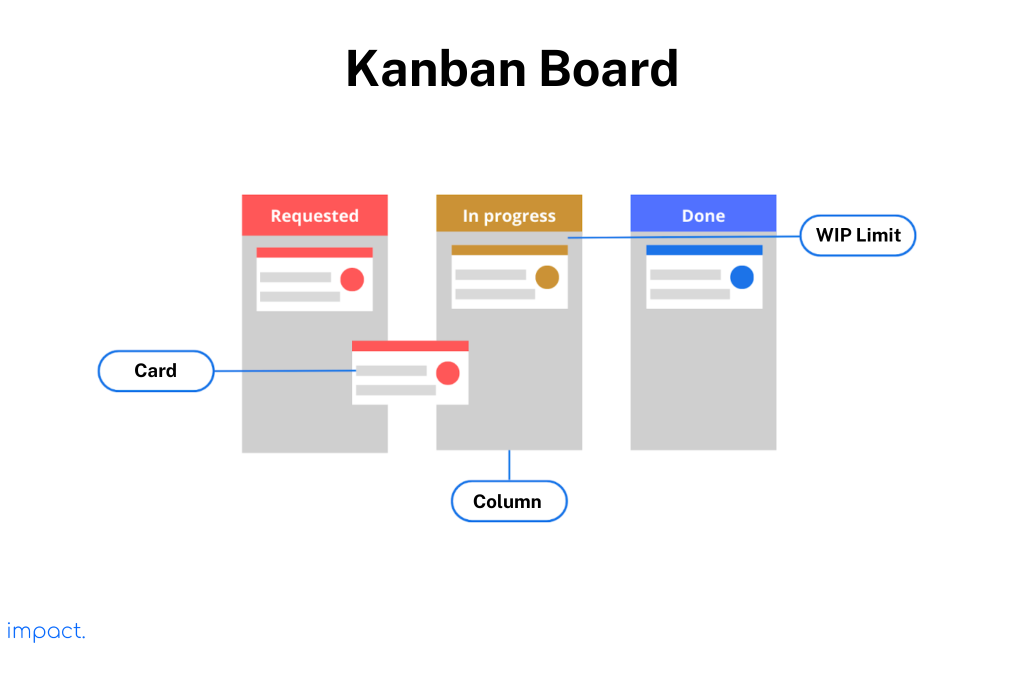12 Vital Retail Metrics & KPIs for Your Business Success
Our retail guide’s last chapter explored ways to boost your store’s success through innovative finance,…
Sean Thobias
November 19, 2024Kanban is a crucial part of the Just in Time (JIT) system, which we discussed in the preceding chapter. It serves as the wall of the House of Lean Production.

Kanban is a method that visualizes work, maximizes efficiency, and improves operations. A Kanban board displays jobs, enabling workers to handle complex projects in a single environment.
Below, we explain Kanban’s definitions, rules, and benefits when implemented in companies.
Kanban helps with JIT production. The term comes from Japan and means a visual board or sign. Toyota was the first to use this method as a schedule for Just-in-Time manufacturing.
However, “Kanban” refers to the “Kanban Method” that originated in 2007. It is a production process that operates on a pull system and encompasses pertinent information such as:
Other forms include:
Read more: Lean Manufacturing: Definition & 3 Advantages to Utilize
In practice, there are two commonly used types of Kanban:
These two types of Kanban work together, as shown in the figure below:

The assembly line produces goods A, B, and C by purchasing parts a, b, and c from the spare parts shop using Kanban withdrawal. Any shortage leads to the creation of production Kanban for processes 1, 2, and 3, which produce replacement parts. The company manufactures recalled items strictly in the order customers request, guaranteeing defect-free products are delivered.
If the parts store runs out of part A, the customer should submit the withdrawal Kanban to process 1. Process 1 will then schedule the work and fulfill the order. Below is an example of a withdrawal Kanban and a production Kanban:

Source: Dennis, P. (2017). Lean production simplified; Production and withdrawal kanban
To effectively implement Kanban, workers, and supervisors require a profound understanding of its rules and strong problem-solving skills. The rules for Kanban implementation encompass the following:
Companies must follow Rule 1, which means they should avoid making defective products. If a company produces faulty products, it wastes labor, materials, and time as these items are unfit for sale. This hampers cost-reduction efforts and prevents them from achieving their goals. According to Rule 1, companies must:
The previous chapter discussed the concept of Just in Time. To address critical production problems, companies need to ensure they have product stock available in the required quantity when customers come to make a purchase. This way of thinking helps answer the following questions:
Rule 2 has the following consequences:
To avoid problems caused by producing too much, too soon, or with the wrong parts, it’s essential to be mindful. These mistakes can lead to unnecessary overtime, excess inventory, and wasted resources due to not realizing we already have enough capacity. It’s crucial to accurately assess and ensure that our existing capacity is sufficient to prevent these inefficiencies.
Rule 3 is based on rule 2, allowing production processes to work together like an assembly line. Kanban connects customers and suppliers. The following are the outcomes of rule 3:
We must design the production scheduling board to ensure transparency in order and quantity.
Companies must maintain stability in their orders to achieve accurate and timely production. Ordering 50 pieces in one hour and suddenly increasing it to 250 in the next hour would lead to overproduction. Therefore, companies must recall products on time, in fixed quantities, and in a predetermined order.
The Kanban system doesn’t suit many production changes. It serves as a tool for fine-tuning processes. For instance, when a customer pulls out pieces at an unstable rate (e.g., 100 pieces in the first hour, 200 pieces in the second hour, and 75 pieces in the third hour), it results in inventory buildup and overcapacity for the company.
Companies must apply the jidoka principle to improve process capability and actively address muda, mura, and muri. To accomplish this, you can:
Organizations must carefully follow six practical steps to implement the Kanban method successfully. Let’s go through each step in the Kanban implementation process:
Using this system, you can visualize work processes using board media with cards and columns. Each column on the board represents a step in the workflow, while each Kanban card represents a work item. The board accurately reflects the current state of the workflow, including all risks and specifications.

Firstly, it’s vital that you understand how to turn a request into a tangible end product. Understanding the flow of work within the system will enable you to embark on a journey of continuous improvement or kaizen, where necessary changes can be implemented and observed.
When you work on item X, drag it from the “Requested” column to the “Done” column upon completion. This action allows for effortless progress tracking and issue identification. Naturally, the appearance of your board may vary based on your unique requirements and workflows.
Kanban‘s primary purpose is to ensure you don’t have too many things in progress simultaneously. If you don’t limit the amount of work you can do, then you’re not using Kanban.
Changing what your team focuses on in the middle of a project is not a good idea because it can mess up the whole process. Trying to do multiple things simultaneously is also a waste of time and makes things less efficient.
Limiting your work in progress means you only move on to the next step when you have space. This action helps you see any problems and deal with them quickly.
Managing flow involves managing work items as they move through the production process at a predictable and continuous pace. When implementing a Kanban system, a key objective is establishing a smooth and efficient flow. Focus on managing work processes to speed advancement rather than excessive control and constant busyness. Consequently, your system will generate value more rapidly.
To improve something, you must first understand it. Therefore, clearly defining, publicizing, and socializing your process is crucial. People won’t engage with or support something they don’t believe in.
When everyone is familiar with the shared objectives, they can effectively collaborate and make decisions to create a positive impact. Implementing employment policies that are infrequent, visible, well-defined, and adaptable when needed can empower workers to regulate themselves.
The company ensures that the organization effectively responds to potential changes and helps share knowledge among stakeholders. Kanban recommends using cadence at the team and service levels.
To establish a team-level cadence, a daily meeting can be held. This meeting keeps track of the status and flow of work, allowing us to see how much capacity is available and find ways to improve delivery speed. It takes place in front of the Kanban board, and each member shares what they accomplished the previous day and their plans for today.
Having focused and regular meetings with fewer participants is a good practice. However, determining how long a specific Kanban cadence depends on your situation, team size, and the topic you’re discussing.
To keep improving and making organizational changes, we must work together, use methods we know work, listen to feedback, and measure our progress. It’s essential to evaluate the impact of every idea we have so we can create a culture that values new and better ways of doing things. This approach helps us develop a mindset focused on minor improvements over time.
According to the 1st State of Kanban report, companies use this methodology primarily to make work more visible and continuously improve. Here are some of the benefits companies gain from using Kanban:
The central concept of Kanban is to represent each job visually. The Kanban board transforms into a central information hub, ensuring everyone is aligned. All tasks are readily visible and never vanish, promoting transparency throughout the work process.
Kanban empowers companies to monitor and analyze work distribution information closely. Identifying stages with the most extended task durations and bottlenecks becomes effortless by providing a clear view of completed work items within a specific period. By doing this, the system improves workflow and speeds up how quickly products are delivered.
Kanban practices help companies align their big goals with everyday work by being transparent, giving feedback, and holding regular review meetings. This connection between the business direction and what gets done improves how quickly the organization can respond to changes. It allows the team to quickly adjust to new priorities, market changes, or what customers want.
Once you make a board and add work items, you can learn more about the process using flow metrics. You can improve your predictions about future work by analyzing how much time tasks spend in the workflow (cycle time). Understanding how consistent your delivery rates are (throughput) will help you make better estimates and decisions based on past data.
The Kanban method originates from the pull system, which ensures work completion upon request. In simpler terms, it strives to minimize waste by focusing solely on necessary tasks. You can guarantee that the outcome meets customer expectations by utilizing visualization techniques and implementing work limits.
Also read: Manufacturing Computer Software: 3 Types & How to Choose
Kanban is a method that makes work more visible and controllable. It helps companies identify inefficient business processes and find solutions. To implement Kanban effectively, follow the six rules mentioned in this chapter.
After grasping this concept, the following chapter will delve into production leveling, also referred to as heijunka, another crucial element of Just in Time.
Dennis, P. (2017). Lean production simplified: a plain-language guide to the world’s most powerful production system. Crc press.
Impact Insight Team
Impact Insights Team is a group of professionals comprising individuals with expertise and experience in various aspects of business. Together, we are committed to providing in-depth insights and valuable understanding on a variety of business-related topics & industry trends to help companies achieve their goals.
75% of digital transformation projects fail. Take the right first step by choosing a reliable long-term partner.
